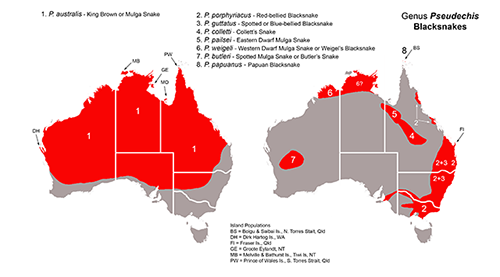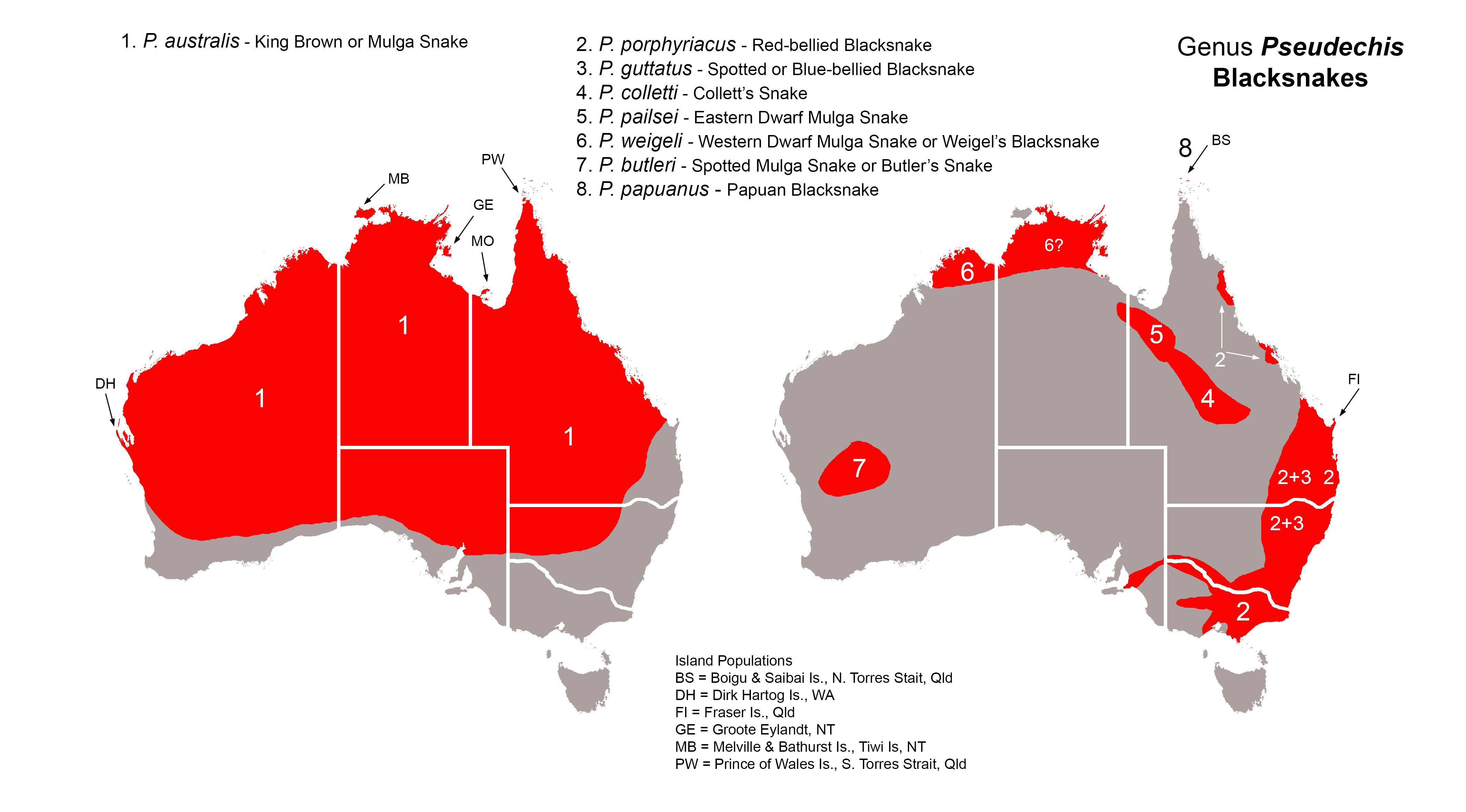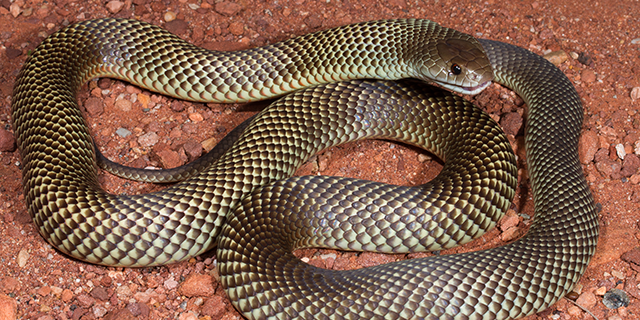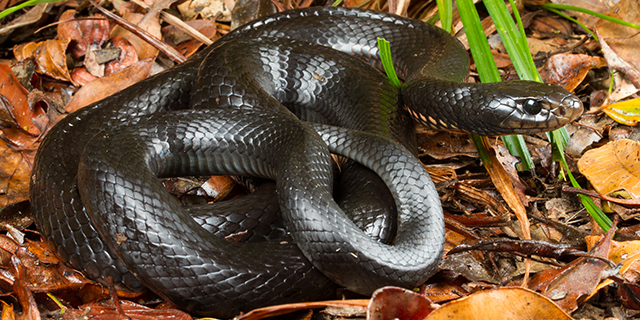Australo-Papuan Black Snakes

Distribution map of Black Snakes

Just as “brown snakes” are not always brown and “tiger snakes” are not always banded, “black snakes” are not always black. The genus Pseudechis includes some of Australia’s most beautiful snakes, as well as (arguably) its largest venomous species – the mulga snake (sometimes misleadingly referred to as the “king brown”). On the other end of the size spectrum from the mulga snake are the dwarf or pygmy mulga snakes, some of which rarely exceed 1 metre in length. Black snakes are diverse in ecology and occur over most of the continent, excluding the extreme southwest and Tasmania, in almost all habitat types. Although red-belled black snakes (P. porphyriacus) have a fearsome reputation, in reality bites from these snakes to humans are infrequent, and often result from people interfering with the snake directly. On the other hand, in the amateur herpetological community bites from red-bellied black snakes are often not taken seriously, which is unwise as irreversible myotoxicity may result from envenomations by this snake if antivenom is not rapidly (within 6 hours of the bite) administered. Unlikely many other Australian venomous snakes, bites from black snakes may be associated with significant local damage, including necrosis (tissue death). As a result of this, in multiple cases digits (P. australis and P. porphyriacus) and even limbs (P. australis) have had to be amputated following bites from these snakes. Another unusual consequence of bites from black snakes is either transient or permanent anosmia (loss of sense of smell).
A positive and widespread piece of folk wisdom about red-bellied black snakes is that they eat the more dangerous eastern brown snakes (Pseudonaja textilis), and thus if red-bellied black snakes are present, brown snakes will not be. Unfortunately, this is not entirely true – whilst red-bellied black snakes will certainly eat brown snakes (and other snakes), and thus may contribute to keeping their numbers down, the presence of black snakes is no guarantee as to the absence of brown snakes. It is an interesting fact, however, that black snakes appear immune to the venom of brown and other venomous snakes, as they have been observed receiving multiple bites from their toxic prey without apparent ill effect.
Distribution: Mainland Australia, also southern New Guinea.
Distinguishing characteristics: Body slender to moderately stout, with smooth, often glossy, scales in 17-19, rarely 21, rows at midbody, head rounded, eyes with round pupils, subcaudals may be anteriorly single, posteriorly divided, or all single or all divided.
Australian species: Pseudechis australis, P. butleri, P. colletti, P. guttatus, P. pailsi, P. papuanus, P. porphyriacus, P. weigeli.
International species: P. rossignolii (Hoser, 2000) Papuan Dwarf Mulga Snake.
Habitat: Black snakes occupy most habitats available across the range of the genus, with some species occurring in very arid desert habitats and other species predominantly in wetland areas.
Activity: Either nocturnal or diurnal, with northern and desert species tending towards nocturnal lifestyles and southern species being primarily diurnal.
Diet: Black snakes are typically generalists, although some species have relatively specialised diets. Wetland species may specialise in feeding upon frogs, while arid habitat species prey more on lizards, sometimes snakes. All will take small mammals at least occasionally and birds are infrequent prey.
Reproduction: Eight Pseudechis species are oviparous, laying clutches of 8-20 eggs, but the southern-most species, P. porphyriacus, is ovoviviparous, producing litters of up to twelve neonates.
Venom composition: Black snake venoms are typically myotoxic and anticoagulant, and although clinically significant coagulopathy is rare, evidence of blood disturbances may be a useful early indicator of envenomation. As myotoxicity is a preventable, but irreversible, consequence of black snake envenomation, once evidence of a systemic pathology is available antivenom should be administered immediately. The venoms of P. papuanus and P. porphyriacus are apparently unique amongst those of members of this genus in including procoagulant (the same as those in tiger snake venom) as well as anticoagulant toxins, but again significant coagulopathy is rare. Black snake venoms contain neurotoxins, and are neurotoxic in vitro, but neurotoxicity is rare in bite victims. An exception to this may be P. papuanus, a minor cause of snakebite in Papua New Guinea, which causes reversible neurotoxicity in some bite victims. The most dangerous member of the genus is likely P. australis, partly because of its exceptionally large venom yield (although P. papuanus may also deliver huge quantities of venom). At least one death can be definitively attributed to P. australis envenomation, the cause of which was likely renal failure secondary to myotoxicity.
The recommended treatment for bites from black snakes is Seqirus (bioCSL) Tiger Snake Antivenom (TSAV), except for P. australis and P. papuanus bites, which should be treated with the specific Black Snake Antivenom (BSAV).
Pseudechis australis (Gray, 1842)
King Brown snake or Mulga Snake
Distribution: ACT; NSW (northwest); NT; Qld (except southeast); SA (except south); WA (except south).
Islands: Dirk Hertog Is, WA; Melville & Bathurst Is, & Groote Eylandt, Qld; Mornington Is & Prince of Wales Is, Southern Torres Strait, Qld.
Length: 1.5 - 2.0 m, occasionally 2.5 m
Distinguishing characteristics: Dorsal scales smooth, in 17 rows at midbody; ventrals 185-225; cloacal plate divided; subcaudals 50-80, single anteriorly, divided posteriorly, occasionally all single; six supralabials; temporolabial present.
Colouration & patterning: There is considerable regional variation in the colour of this species, although it is typically uniformly coloured (though occasionally speckled). The dorsum may be red-brown, yellow-brown or olive-brown, scale are sometimes dark edged presenting a reticulate appearance; the venter is white or cream.
Habitat: Most habitats available across the range, from rainforest and monsoon forest to woodland and desert.
Activity: Nocturnal in the north or in hot weather, often diurnal in the south.
Diet: Mulga snakes primarily feed on reptiles including lizards and snakes (including venomous species), but are opportunistic generalists and will also take small mammals, frogs, and occasionally birds.
Reproduction: Oviparous, with clutches of 8-20 eggs.

-

Pseudechis australis - Figure 1
Figure 1: Pseudechis australis -

Pseudechis australis - Figure 2
Figure 2: Pseudechis australis -

Pseudechis australis - Figure 3
Figure 3: Pseudechis australis -

Pseudechis australis - Montage
Pseudechis australis: Montage showing range of colour variation within this species in Western Australia (Photo - Brian Bush)
Pseudechis butleri Smith, 1982
Spotted Mulga Snake or Butler’s Snake
Distribution: WA (south-central).
Length: 1.2-1.6 m
Distinguishing characteristics: Dorsal scales smooth, in 17 rows at midbody; ventrals 200-220; cloacal plate divided; subcaudals 50-70, single anteriorly, divided posteriorly; six supralabials; temporolabial present.
Colouration & patterning: Dorsum dark grey or black, most scales with a large yellow or pale brown blotch but with clusters of entirely dark scales, head and neck also dark without light spots, pattern less evident in blue-grey juveniles; venter yellowish with dark basal edge to each scale.
Habitat: Arid black-soil mulga woodland and scrubland.
Activity: Nocturnal or diurnal dependent on weather.
Diet: Primarily lizards, occasionally small mammals.
Reproduction: Oviparous, with clutches averaging ten eggs.
Pseudechis colletti Boulenger, 1902
Collett’s Snake
Distribution: Qld (south-central).
Length: 1.2 - 1.5 m
Distinguishing characteristics: Dorsal scales smooth, in 19 rows at midbody; ventrals 215-235; cloacal plate divided; subcaudals 50-70, single anteriorly, divided posteriorly; six supralabials; temporolabial present.
Colouration & patterning: Dorsum rich brown, grey, or black, with crossbands of paler pigment, cream to red, which also extends along the lower flanks; venter cream, yellow or orange.
Habitat: Arid grasslands on a clay substrate or black-soil plains.
Activity: Nocturnal or diurnal dependent on weather.
Diet: Unusually for a black snake, P. colletti apparently feeds primarily on small mammals, but will also take frogs.
Reproduction: Oviparous, with clutches averaging twelve eggs.
Pseudechis guttatus De Vis, 1905
Spotted or Blue-bellied Black snake
Distribution: NSW (southeast); Qld (northeast).
Length: 1.2 - 1.5 m
Distinguishing characteristics: Dorsal scales smooth, in 19 rows at midbody; ventrals 175-205; cloacal plate divided; subcaudals 45-75, single anteriorly, divided posteriorly; six supralabials; temporolabial present.
Colouration & patterning: Dorsum variable, from uniform black, to each scale speckled with cream, red or brown, to fully pale with black scale tipping; venter grey to blue-grey.
Habitat: Riverine floodplains, wetlands, dry sclerophyll forest and woodland.
Activity: Nocturnal or diurnal dependent on weather.
Diet: An opportunistic generalist that primarily feeds on frogs, but occasionally on small mammals, lizards, and (rarely) invertebrates.
Reproduction: Oviparous, with clutches averaging twelve eggs.
Pseudechis pailsi (Hoser, 1998)
Eastern Dwarf Mulga Snake
Distribution: Qld (Mt Isa); NT (northeast).
Length: 1.2 - 1.5 m
Distinguishing characteristics: Dorsal scales smooth, in 17 rows at midbody; ventrals 210-230; cloacal plate divided; subcaudals 50-80, single anteriorly and divided posteriorly, or entirely single; six supralabials; temporolabial present.
Colouration & patterning: Dorsum mid to dark brown, venter white, cream or pink.
Habitat: Rocky spinifex grasslands.
Activity: Nocturnal or diurnal dependent on weather.
Diet: Poorly known – existing records indicate that the eastern dwarf mulga snake primarily feeds upon lizards, especially skinks. It is likely, however, that it will opportunistically feed on frogs and possibly mammals.
Reproduction: Oviparous, clutch size unknown.
Pseudechis papuanus Peters & Doria, 1878
Papuan Black snake
Distribution: Qld (Torres Strait).
Islands: Boigu & Saibai Is, Northern Torres Strait, Qld.
Extralimital: Southern New Guinea (WNG & PNG).
Length: 1.5 - 2.0 m, occasionally 2.2 m
Distinguishing characteristics: Dorsal scales smooth, in 19, occasionally 21, rows at midbody; ventrals 215-230; cloacal plate divided; subcaudals 54-66, single anteriorly and divided posteriorly, or all divided; six supralabials; temporolabial present.
Colouration & patterning: Dorsum glossy blue-black, occasionally matt brown; venter grey, often white under the throat.
Habitat: Coastal woodland, wetlands, and swamps.
Activity: Nocturnal or diurnal dependent on weather.
Diet: Predominantly frogs and small mammals.
Reproduction: Oviparous, with clutches of 9-18 eggs.
Pseudechis porphyriacus (Shaw, 1794)
Red-bellied Black snake
Distribution: ACT; NSW (east & south); Qld (southeast & east); SA (southeast); Vic (east & north).
Islands: Fraser Is, Qld.
Length: 1.5 - 2.0 m
Distinguishing characteristics: Dorsal scales smooth, in 17 rows at midbody; ventrals 170-215; cloacal plate divided; subcaudals 40-65, single anteriorly and divided posteriorly, or all single; six supralabials; temporolabial present.
Colouration & patterning: Dorsum glossy black or dark grey, with red infusion on lower flanks extending on venter, which is centrally cream or pink.
Habitat: Wetlands, lake sides, swamps, creeks, seasonally flooded grassland and woodland, occasionally in more arid habitats.
Activity: Usually diurnal.
Diet: Regional variation is documented in the diet of red-bellied black snakes, but they are essentially generalists. As they are often associated with water, frogs are a dominant component of their diet, but they also eat lizards, other snakes and small mammals.
Reproduction: Ovoviviparous, with litters of up to twelve neonates.

Pseudechis weigeli (Wells & Wellington, 1987)
Western Dwarf Mulga Snake
Distribution: WA (Kimberley).
Length: 1.3 - 1.5 m.
Distinguishing characteristics: Dorsal scales smooth, in 17 rows at midbody; ventrals 210-230; cloacal plate divided; subcaudals 50-80, single anteriorly and divided posteriorly, or all single; six supralabials; temporolabial present.
Colouration & patterning: Dorsum pale to mid-brown or red-brown; venter cream to white.
Habitat: Tropical savannah woodland, and monsoon vine-forest.
Activity: Nocturnal or diurnal dependent on weather.
Diet: Poorly known – probably reptiles and frogs, possibly small mammals.
Reproduction: Oviparous, clutch size unrecorded.
Species occurring in New Guinea:
Pseudechis rossignolii (Hoser, 2000)
Papuan Dwarf Mulga Snake
Distribution: Southern New Guinea, Papua Province, and southwestern Western Province, PNG; also West Papua.
Length: 0.7 - 1.0 m, occasionally 1.1 m
Distinguishing characteristics: Dorsal scales smooth, in 17 rows at midbody; ventrals 186-191; cloacal plate divided; subcaudals 51-62, all single; six supralabials; temporolabial present.
Colouration & patterning: Dorsum yellow-brown to mid-brown or red-brown, venter cream with small orange blotches.
Habitat: Lowland habitats, probably associated with water, but poorly known.
Activity: Probably diurnal.
Diet: Poorly known - probably reptiles and frogs, possibly small mammals.
Reproduction: Oviparous, with clutches of up to twelve eggs.